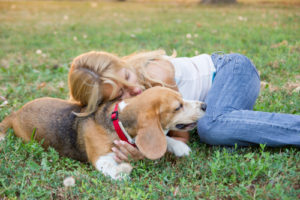There is a magical time between the ages of 7 and 10, depending on the breed, that a dogs muzzle gets a bit grayer and they may move a little slower up the stairs. That fuzzy, green tennis ball isn’t as important as a warm, fluffy bed and the food they’ve eaten for years tends to disagree with their system. Some dogs become a little stiffer in the joints, or begin to pack on the pounds without a change in their diet. How does an owner usher in the march of time without too much disruption to a dog’s lifestyle?
Change in routine
Dogs thrive on routine and dependability. Senior dogs require a little shifting to their lifestyle but not much. Visits to the vet should be increased from once a year to twice a year. One of the reasons is to catch potential problems earlier, giving the dog a greater possibility of recovery. Keep lines of communication open. Alert the vet if there are sudden changes in the dog’s temperament or physical demeanor.
 Dietary Dilemma
Dietary Dilemma
With aging come physiological changes as well. A dog may have been eating the same brand of food and the same portion amount for years, suddenly she develops horrible gas or diarrhea. Or the dog may still digest the food fine, but begins to gain weight. Switching to a dog food made specifically for a senior’s digestion, may make mealtimes less stressful.
Activity Level
Taking a senior out for a daily walk is as important as taking a puppy out. Although the senior may not have as much energy as a rambunctious puppy, they still need to daily exercise to keep them healthy. Owners must watch the dog for stiffening or sore joints while out walking. If the dog starts limping, bring her home, put a warm compress on the joint (If she’ll let you) and monitor her for a day or two. If the condition gets worse, or the dog appears to be in pain, call the vet. There are a number of ailments involving the limbs and joints.
Other concerns
It’s been determined, the dog is a senior. Vet appointments have increased, diet has changed and exercise is still a priority—Now what? Add in weekly brushing or stroking. While most owners probably pet their dogs every day, it is a good habit for the owner of a senior dog to brush or stroke the dog from head to tail. Doing this allows the owner to check for unusual lumps or bumps. Abnormal masses should be checked by the vet.
[ildsarticlebelowSome of the older seniors may have a difficult time regulating their body temperature. It is encouraged to keep older dogs indoors, especially during spells of extreme heat or cold.
Owners should cherish and appreciate all their dog has done for them. Give them extra hugs and kisses. After all, sad to say, dogs don’t live forever, love them while you can!
